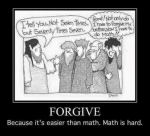-
I am not really sure what you mean, but there are times when the premise is true but the conclusion is false.
Discrete Mathematics can show this..... and @posthuman can check it if he likes 
The premises are therefore s→a and a and the conclusion is c.
To show this argument is invalid, we find truth values to make all of the premises true, but the conclusion false.
If we set s=F and a=T, we have s→a≡F→T≡T and a≡T, and so the premises are true.
However, the conclusion is s≡F so the conclusion is invalid.
(credit Carleton U)
- If I did all the suggested exercises, then I got an A+
- I got an A+
- Therefore, I did all of the suggested exercises.
The premises are therefore s→a and a and the conclusion is c.
To show this argument is invalid, we find truth values to make all of the premises true, but the conclusion false.
If we set s=F and a=T, we have s→a≡F→T≡T and a≡T, and so the premises are true.
However, the conclusion is s≡F so the conclusion is invalid.
(credit Carleton U)
hooray math!
i found the source you quoted from; here it is with a little more context:
Not all arguments are valid! To show an argument is invalid, find truth values for each proposition that make all of the premises true, but the conclusion false.
This works because proving an argument is valid is just showing that an implication is true. Therefore, to show an argument is invalid, we need to show that the implication is false. An implication is false only when the hypothesis is true and the conclusion is false. Since the hypothesis is the conjunction of the premises, this means that each premise is true and the conclusion is false.
- Consider the argument:
- If I did all the suggested exercises, then I got an A+
- I got an A+
- Therefore, I did all of the suggested exercises.
- Let ss denote "I did all of the suggested excerises" and aa denote "I got an A+." The premises are therefore s→as→a and aa and the conclusion is cc. To show this argument is invalid, we find truth values to make all of the premises true, but the conclusion false. If we set s=F s=F and a=Ta=T, we have s→a≡F→T≡Ts→a≡F→T≡T and a≡Ta≡T, and so the premises are true. However, the conclusion is s≡Fs≡F, and so the argument is invalid.
- If I did all the suggested exercises, then I got an A+
the important bit is at the top of the quote: it's when premises are true but conclusions are false that you have an invalid argument. it's proven invalid by contradiction: the premises lead to a conclusion that contradicts the premises. this tells you, you were using bad logic.
here's the example he gave in a little clearer terms, i hope:
- Consider the argument:
- If I did all the suggested exercises, then I got an A+
- I got an A+
- Therefore, I did all of the suggested exercises.
- Let:
- X = {do all the exercises}
- Y = {get an A+}
- The premises are:
- X → Y
- read this as "X implies Y" or "if X, then Y"
- X → Y
- the conclusion is:
- Y → X
- suppose that X is true and Y is false.
- then:
- {X = T} ⇒ Y = T, since X → Y
- read this as 'X is True. it follows that Y is true, since X implies Y'
- {Y = T} ⇒ F = T, since Y = F
- read this as 'the fact that Y is true implies false is True, since we know Y is false
- really should have stopped there =\
- {F = T} ⇒ X = F, since we know X = T
- he concludes X is false, contradicting that X is true, on the basis that false is the same as true.
- this is extraneous at this point, we knew what we were looking at was invalid the moment we got Y is true, because that contradicted the premises. the author of this proof was noob at the time he wrote it, IMO. or very tired, more likely, from staying up for days to write that webpage, and missed that he made the same argument twice when he only needed it once.
- {X = T} ⇒ Y = T, since X → Y
you might have done extra credit.
the teacher might drop the lowest grade, and maybe you did all but one homework, and got A + on all you did but a zero on the one you didn't do, however the zero was dropped & didn't count.
and here's a bonus: a more beautiful proof, in a more beautiful form:
- let TRUE = 1, FALSE = 0
- let E = the collection of events e1 . . eN where each event ek is the doublet {Xk, Yk}
- the premise X → Y can then be encoded as:
- X + Y > X
- hypothesis: Y → X
- ⇒ Y + X > Y
- suppose that there exits an event in E: ei = {1, 0}
- X + Y = 1 > 0 = X
- the premise holds
- Y + X = 1 = X
- the hypothesis fails
- X + Y = 1 > 0 = X
- therefore the hypothesis is invalidated if ∃ e ∈ E, e = {1, 0}
-
1
- Show all


